Psychology Assignment: Behavioral Intervention and Reinforcement
VerifiedAdded on 2022/11/09
|7
|1695
|109
Homework Assignment
AI Summary
This assignment details a student's self-control program designed to address procrastination. The student identifies procrastination as a problem and implements an intervention strategy involving a self-control program. The program includes setting study goals, tracking distractions, and using positive reinforcement (rewards) and negative reinforcement (punishments) to modify behavior. The student records the number of study hours and instances of procrastination, comparing baseline data with program results. The results indicate an increase in study time and a decrease in procrastination, demonstrating the effectiveness of reinforcement techniques. The assignment discusses the impact of reinforcers on behavioral changes and concludes by emphasizing the importance of intervention strategies and psychological tools like classical conditioning and reinforcement in modifying behavior. The student also reflects on the use of the library environment for better study habits.
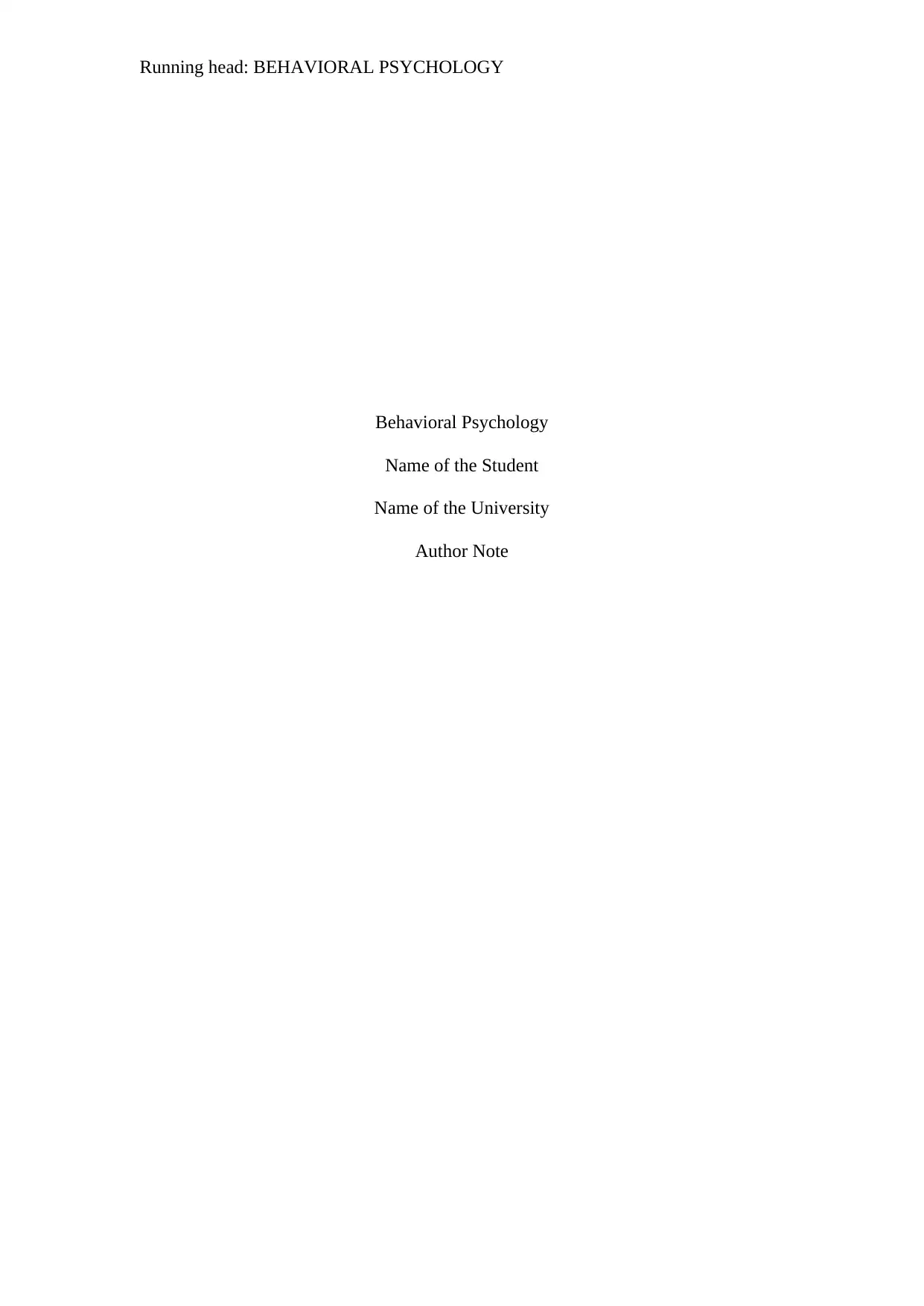
Running head: BEHAVIORAL PSYCHOLOGY
Behavioral Psychology
Name of the Student
Name of the University
Author Note
Behavioral Psychology
Name of the Student
Name of the University
Author Note
Paraphrase This Document
Need a fresh take? Get an instant paraphrase of this document with our AI Paraphraser
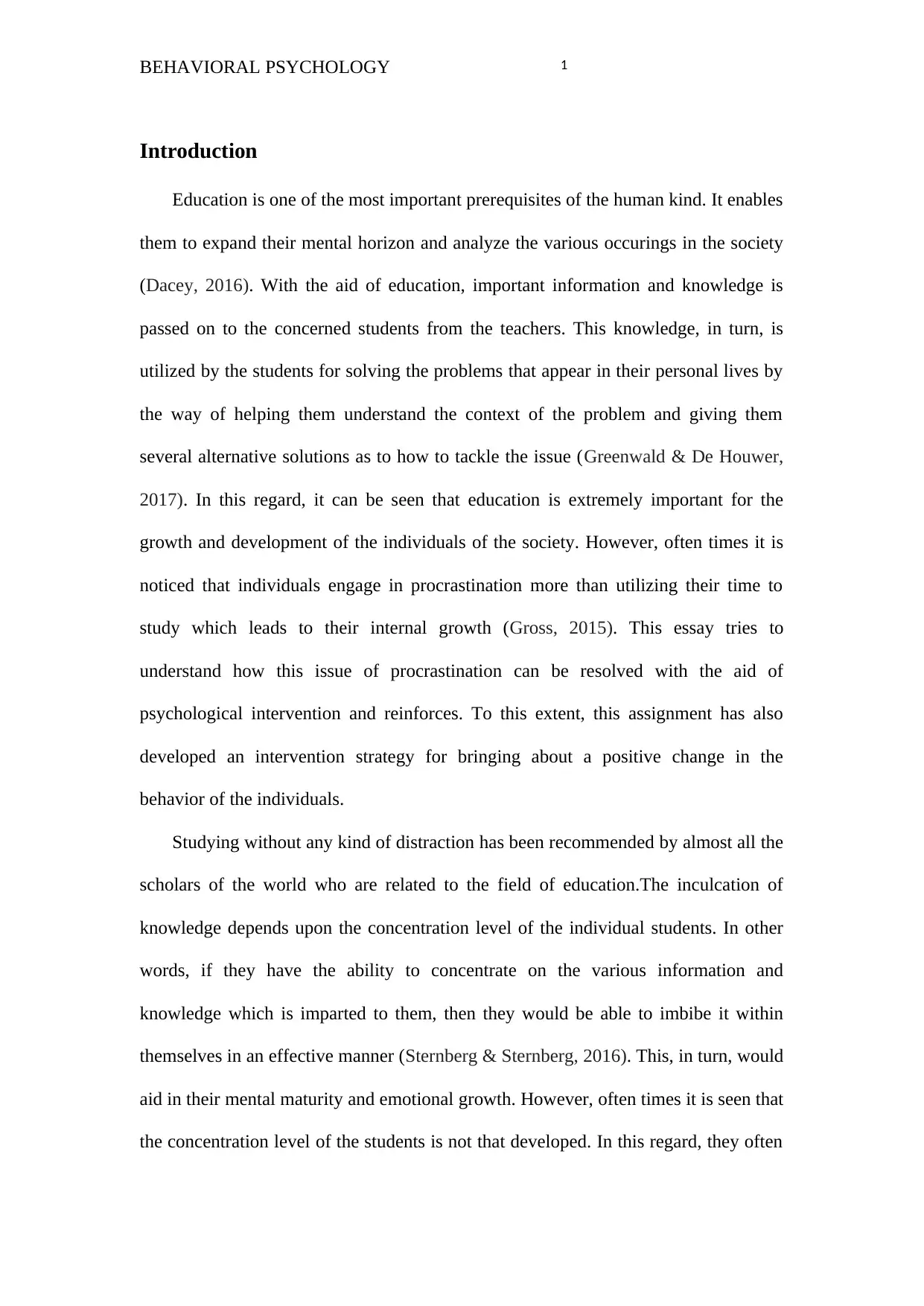
1BEHAVIORAL PSYCHOLOGY
Introduction
Education is one of the most important prerequisites of the human kind. It enables
them to expand their mental horizon and analyze the various occurings in the society
(Dacey, 2016). With the aid of education, important information and knowledge is
passed on to the concerned students from the teachers. This knowledge, in turn, is
utilized by the students for solving the problems that appear in their personal lives by
the way of helping them understand the context of the problem and giving them
several alternative solutions as to how to tackle the issue (Greenwald & De Houwer,
2017). In this regard, it can be seen that education is extremely important for the
growth and development of the individuals of the society. However, often times it is
noticed that individuals engage in procrastination more than utilizing their time to
study which leads to their internal growth (Gross, 2015). This essay tries to
understand how this issue of procrastination can be resolved with the aid of
psychological intervention and reinforces. To this extent, this assignment has also
developed an intervention strategy for bringing about a positive change in the
behavior of the individuals.
Studying without any kind of distraction has been recommended by almost all the
scholars of the world who are related to the field of education.The inculcation of
knowledge depends upon the concentration level of the individual students. In other
words, if they have the ability to concentrate on the various information and
knowledge which is imparted to them, then they would be able to imbibe it within
themselves in an effective manner (Sternberg & Sternberg, 2016). This, in turn, would
aid in their mental maturity and emotional growth. However, often times it is seen that
the concentration level of the students is not that developed. In this regard, they often
Introduction
Education is one of the most important prerequisites of the human kind. It enables
them to expand their mental horizon and analyze the various occurings in the society
(Dacey, 2016). With the aid of education, important information and knowledge is
passed on to the concerned students from the teachers. This knowledge, in turn, is
utilized by the students for solving the problems that appear in their personal lives by
the way of helping them understand the context of the problem and giving them
several alternative solutions as to how to tackle the issue (Greenwald & De Houwer,
2017). In this regard, it can be seen that education is extremely important for the
growth and development of the individuals of the society. However, often times it is
noticed that individuals engage in procrastination more than utilizing their time to
study which leads to their internal growth (Gross, 2015). This essay tries to
understand how this issue of procrastination can be resolved with the aid of
psychological intervention and reinforces. To this extent, this assignment has also
developed an intervention strategy for bringing about a positive change in the
behavior of the individuals.
Studying without any kind of distraction has been recommended by almost all the
scholars of the world who are related to the field of education.The inculcation of
knowledge depends upon the concentration level of the individual students. In other
words, if they have the ability to concentrate on the various information and
knowledge which is imparted to them, then they would be able to imbibe it within
themselves in an effective manner (Sternberg & Sternberg, 2016). This, in turn, would
aid in their mental maturity and emotional growth. However, often times it is seen that
the concentration level of the students is not that developed. In this regard, they often
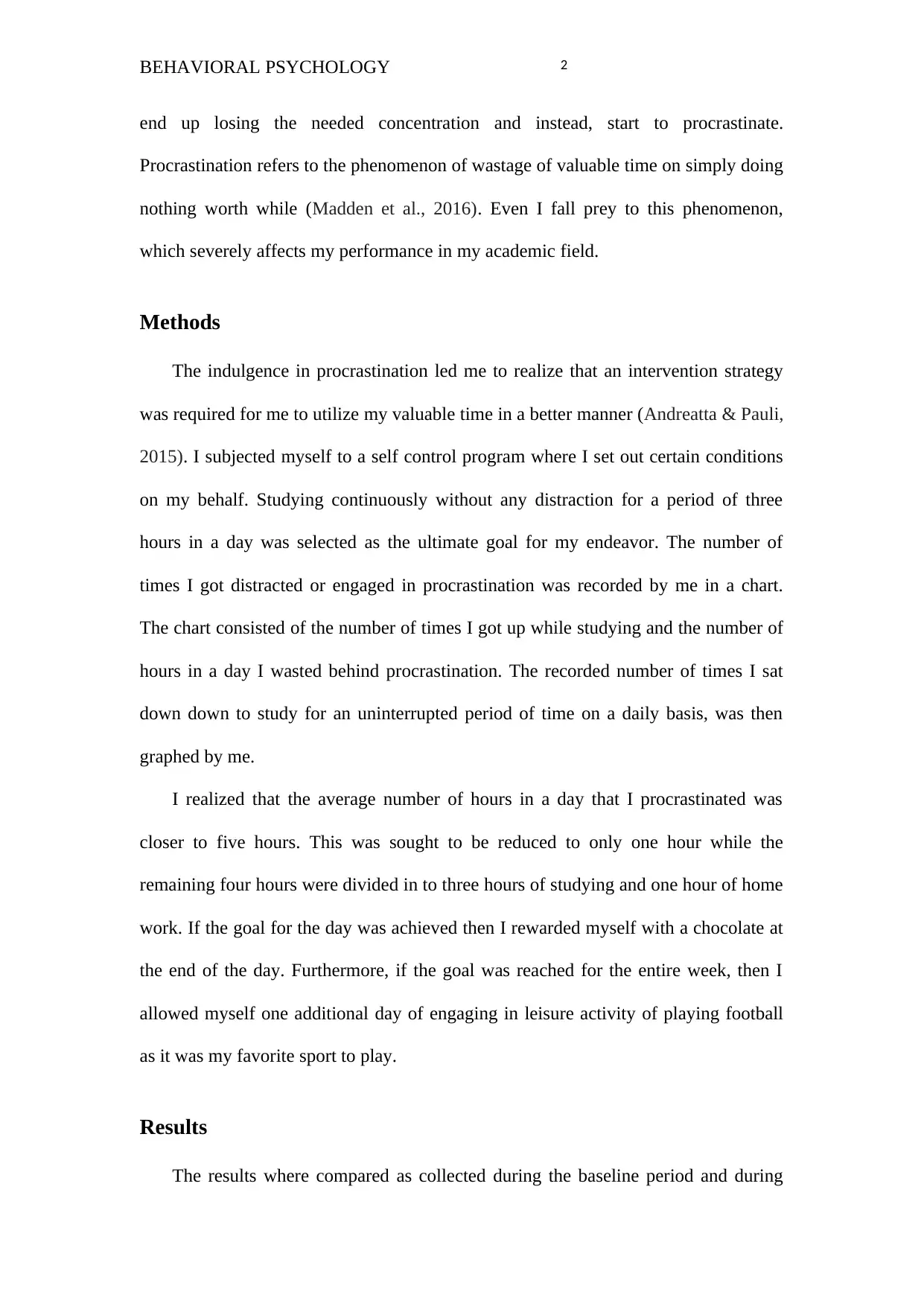
2BEHAVIORAL PSYCHOLOGY
end up losing the needed concentration and instead, start to procrastinate.
Procrastination refers to the phenomenon of wastage of valuable time on simply doing
nothing worth while (Madden et al., 2016). Even I fall prey to this phenomenon,
which severely affects my performance in my academic field.
Methods
The indulgence in procrastination led me to realize that an intervention strategy
was required for me to utilize my valuable time in a better manner (Andreatta & Pauli,
2015). I subjected myself to a self control program where I set out certain conditions
on my behalf. Studying continuously without any distraction for a period of three
hours in a day was selected as the ultimate goal for my endeavor. The number of
times I got distracted or engaged in procrastination was recorded by me in a chart.
The chart consisted of the number of times I got up while studying and the number of
hours in a day I wasted behind procrastination. The recorded number of times I sat
down down to study for an uninterrupted period of time on a daily basis, was then
graphed by me.
I realized that the average number of hours in a day that I procrastinated was
closer to five hours. This was sought to be reduced to only one hour while the
remaining four hours were divided in to three hours of studying and one hour of home
work. If the goal for the day was achieved then I rewarded myself with a chocolate at
the end of the day. Furthermore, if the goal was reached for the entire week, then I
allowed myself one additional day of engaging in leisure activity of playing football
as it was my favorite sport to play.
Results
The results where compared as collected during the baseline period and during
end up losing the needed concentration and instead, start to procrastinate.
Procrastination refers to the phenomenon of wastage of valuable time on simply doing
nothing worth while (Madden et al., 2016). Even I fall prey to this phenomenon,
which severely affects my performance in my academic field.
Methods
The indulgence in procrastination led me to realize that an intervention strategy
was required for me to utilize my valuable time in a better manner (Andreatta & Pauli,
2015). I subjected myself to a self control program where I set out certain conditions
on my behalf. Studying continuously without any distraction for a period of three
hours in a day was selected as the ultimate goal for my endeavor. The number of
times I got distracted or engaged in procrastination was recorded by me in a chart.
The chart consisted of the number of times I got up while studying and the number of
hours in a day I wasted behind procrastination. The recorded number of times I sat
down down to study for an uninterrupted period of time on a daily basis, was then
graphed by me.
I realized that the average number of hours in a day that I procrastinated was
closer to five hours. This was sought to be reduced to only one hour while the
remaining four hours were divided in to three hours of studying and one hour of home
work. If the goal for the day was achieved then I rewarded myself with a chocolate at
the end of the day. Furthermore, if the goal was reached for the entire week, then I
allowed myself one additional day of engaging in leisure activity of playing football
as it was my favorite sport to play.
Results
The results where compared as collected during the baseline period and during
⊘ This is a preview!⊘
Do you want full access?
Subscribe today to unlock all pages.

Trusted by 1+ million students worldwide
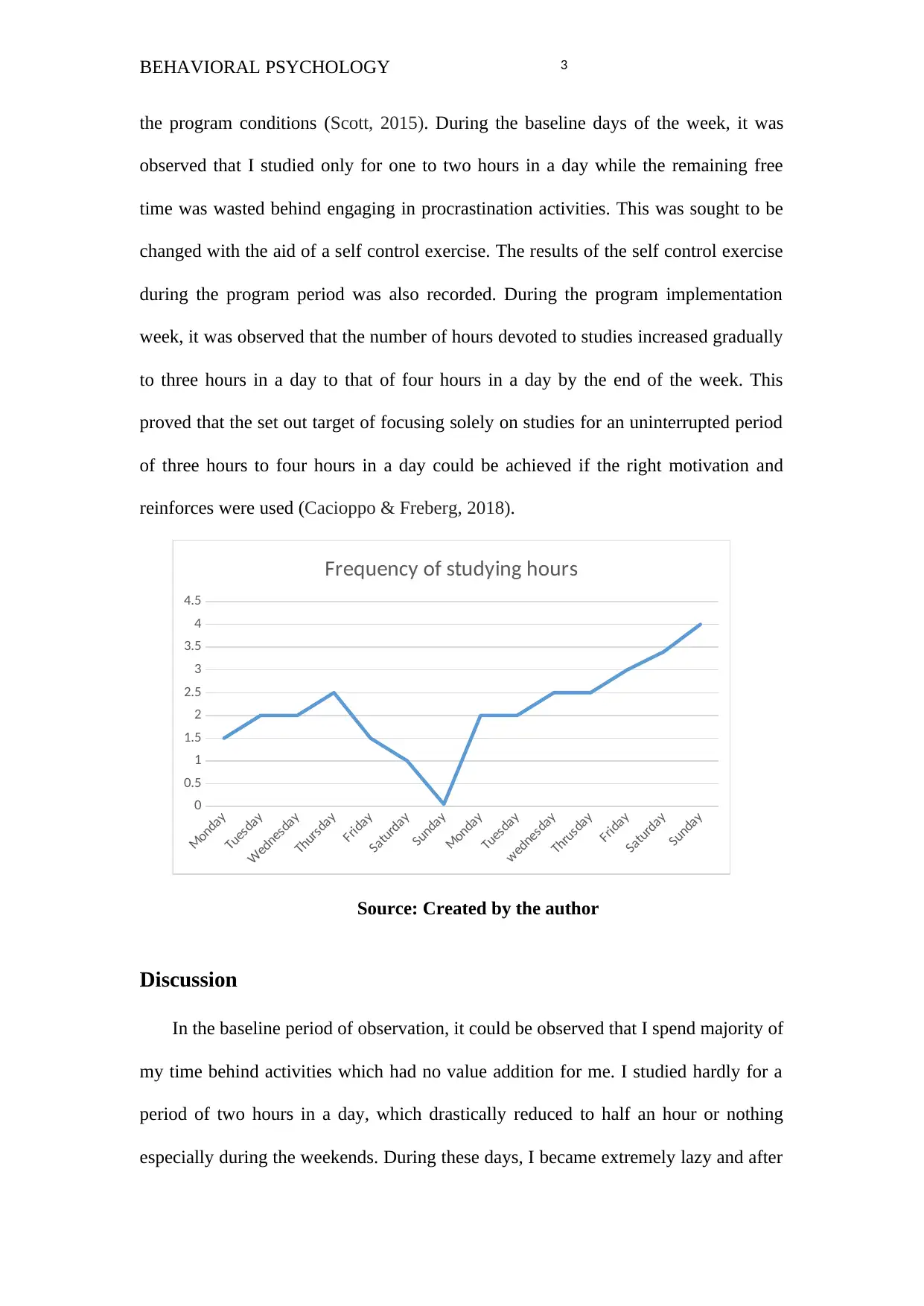
3BEHAVIORAL PSYCHOLOGY
the program conditions (Scott, 2015). During the baseline days of the week, it was
observed that I studied only for one to two hours in a day while the remaining free
time was wasted behind engaging in procrastination activities. This was sought to be
changed with the aid of a self control exercise. The results of the self control exercise
during the program period was also recorded. During the program implementation
week, it was observed that the number of hours devoted to studies increased gradually
to three hours in a day to that of four hours in a day by the end of the week. This
proved that the set out target of focusing solely on studies for an uninterrupted period
of three hours to four hours in a day could be achieved if the right motivation and
reinforces were used (Cacioppo & Freberg, 2018).
Monday
Tuesday
Wednesday
Thursday
Friday
Saturday
Sunday
Monday
Tuesday
wednesday
Thrusday
Friday
Saturday
Sunday
0
0.5
1
1.5
2
2.5
3
3.5
4
4.5
Frequency of studying hours
Source: Created by the author
Discussion
In the baseline period of observation, it could be observed that I spend majority of
my time behind activities which had no value addition for me. I studied hardly for a
period of two hours in a day, which drastically reduced to half an hour or nothing
especially during the weekends. During these days, I became extremely lazy and after
the program conditions (Scott, 2015). During the baseline days of the week, it was
observed that I studied only for one to two hours in a day while the remaining free
time was wasted behind engaging in procrastination activities. This was sought to be
changed with the aid of a self control exercise. The results of the self control exercise
during the program period was also recorded. During the program implementation
week, it was observed that the number of hours devoted to studies increased gradually
to three hours in a day to that of four hours in a day by the end of the week. This
proved that the set out target of focusing solely on studies for an uninterrupted period
of three hours to four hours in a day could be achieved if the right motivation and
reinforces were used (Cacioppo & Freberg, 2018).
Monday
Tuesday
Wednesday
Thursday
Friday
Saturday
Sunday
Monday
Tuesday
wednesday
Thrusday
Friday
Saturday
Sunday
0
0.5
1
1.5
2
2.5
3
3.5
4
4.5
Frequency of studying hours
Source: Created by the author
Discussion
In the baseline period of observation, it could be observed that I spend majority of
my time behind activities which had no value addition for me. I studied hardly for a
period of two hours in a day, which drastically reduced to half an hour or nothing
especially during the weekends. During these days, I became extremely lazy and after
Paraphrase This Document
Need a fresh take? Get an instant paraphrase of this document with our AI Paraphraser
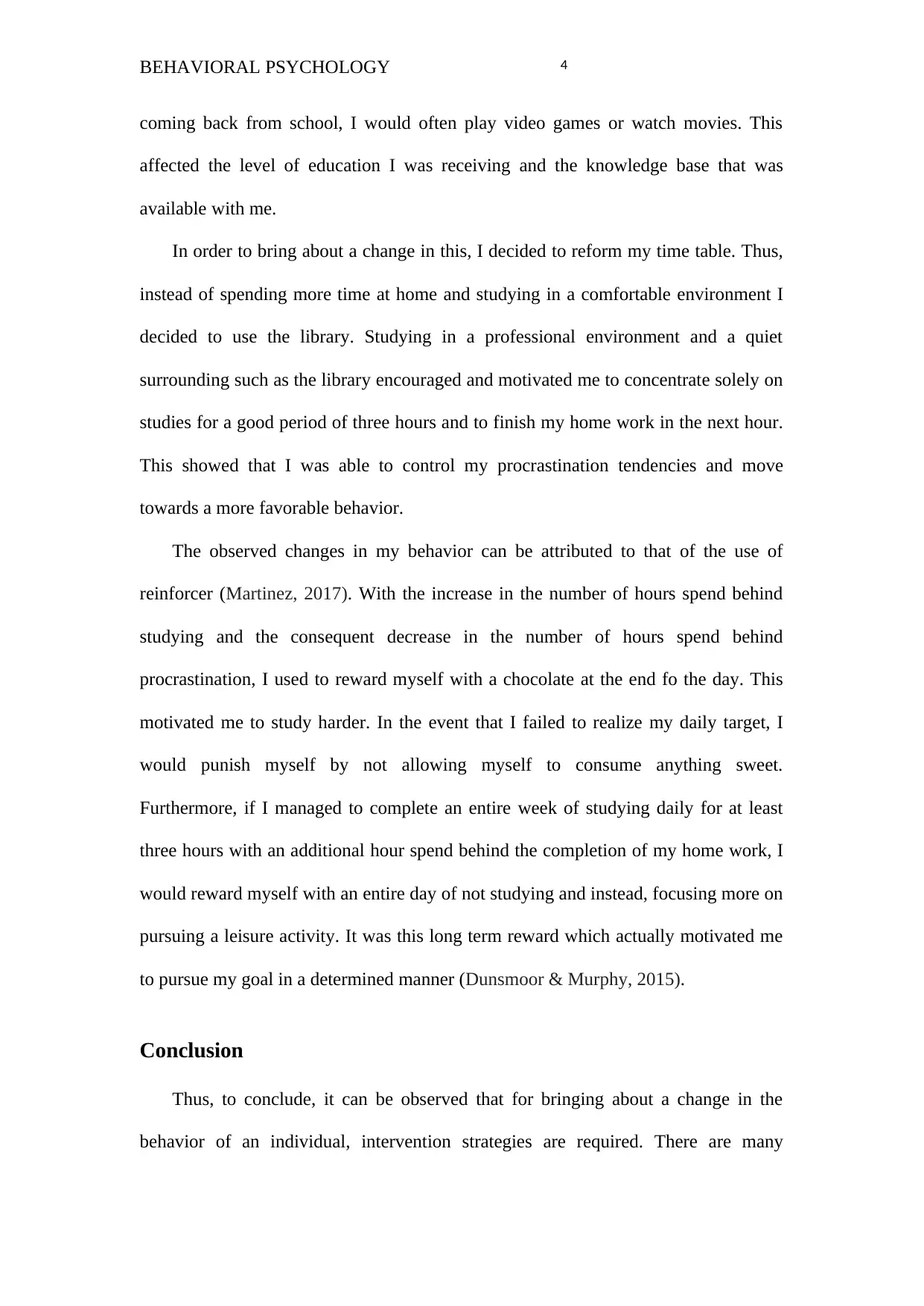
4BEHAVIORAL PSYCHOLOGY
coming back from school, I would often play video games or watch movies. This
affected the level of education I was receiving and the knowledge base that was
available with me.
In order to bring about a change in this, I decided to reform my time table. Thus,
instead of spending more time at home and studying in a comfortable environment I
decided to use the library. Studying in a professional environment and a quiet
surrounding such as the library encouraged and motivated me to concentrate solely on
studies for a good period of three hours and to finish my home work in the next hour.
This showed that I was able to control my procrastination tendencies and move
towards a more favorable behavior.
The observed changes in my behavior can be attributed to that of the use of
reinforcer (Martinez, 2017). With the increase in the number of hours spend behind
studying and the consequent decrease in the number of hours spend behind
procrastination, I used to reward myself with a chocolate at the end fo the day. This
motivated me to study harder. In the event that I failed to realize my daily target, I
would punish myself by not allowing myself to consume anything sweet.
Furthermore, if I managed to complete an entire week of studying daily for at least
three hours with an additional hour spend behind the completion of my home work, I
would reward myself with an entire day of not studying and instead, focusing more on
pursuing a leisure activity. It was this long term reward which actually motivated me
to pursue my goal in a determined manner (Dunsmoor & Murphy, 2015).
Conclusion
Thus, to conclude, it can be observed that for bringing about a change in the
behavior of an individual, intervention strategies are required. There are many
coming back from school, I would often play video games or watch movies. This
affected the level of education I was receiving and the knowledge base that was
available with me.
In order to bring about a change in this, I decided to reform my time table. Thus,
instead of spending more time at home and studying in a comfortable environment I
decided to use the library. Studying in a professional environment and a quiet
surrounding such as the library encouraged and motivated me to concentrate solely on
studies for a good period of three hours and to finish my home work in the next hour.
This showed that I was able to control my procrastination tendencies and move
towards a more favorable behavior.
The observed changes in my behavior can be attributed to that of the use of
reinforcer (Martinez, 2017). With the increase in the number of hours spend behind
studying and the consequent decrease in the number of hours spend behind
procrastination, I used to reward myself with a chocolate at the end fo the day. This
motivated me to study harder. In the event that I failed to realize my daily target, I
would punish myself by not allowing myself to consume anything sweet.
Furthermore, if I managed to complete an entire week of studying daily for at least
three hours with an additional hour spend behind the completion of my home work, I
would reward myself with an entire day of not studying and instead, focusing more on
pursuing a leisure activity. It was this long term reward which actually motivated me
to pursue my goal in a determined manner (Dunsmoor & Murphy, 2015).
Conclusion
Thus, to conclude, it can be observed that for bringing about a change in the
behavior of an individual, intervention strategies are required. There are many
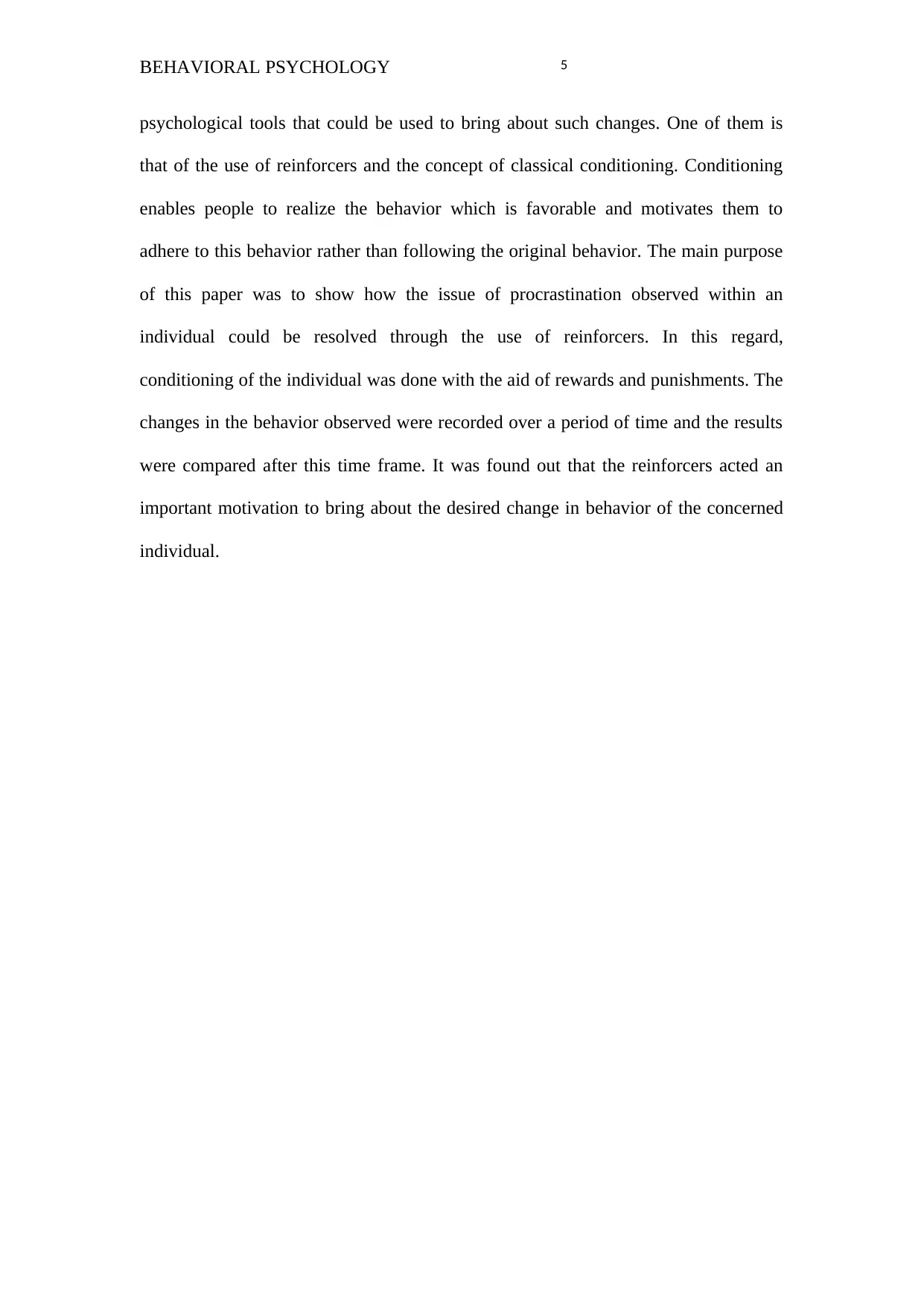
5BEHAVIORAL PSYCHOLOGY
psychological tools that could be used to bring about such changes. One of them is
that of the use of reinforcers and the concept of classical conditioning. Conditioning
enables people to realize the behavior which is favorable and motivates them to
adhere to this behavior rather than following the original behavior. The main purpose
of this paper was to show how the issue of procrastination observed within an
individual could be resolved through the use of reinforcers. In this regard,
conditioning of the individual was done with the aid of rewards and punishments. The
changes in the behavior observed were recorded over a period of time and the results
were compared after this time frame. It was found out that the reinforcers acted an
important motivation to bring about the desired change in behavior of the concerned
individual.
psychological tools that could be used to bring about such changes. One of them is
that of the use of reinforcers and the concept of classical conditioning. Conditioning
enables people to realize the behavior which is favorable and motivates them to
adhere to this behavior rather than following the original behavior. The main purpose
of this paper was to show how the issue of procrastination observed within an
individual could be resolved through the use of reinforcers. In this regard,
conditioning of the individual was done with the aid of rewards and punishments. The
changes in the behavior observed were recorded over a period of time and the results
were compared after this time frame. It was found out that the reinforcers acted an
important motivation to bring about the desired change in behavior of the concerned
individual.
⊘ This is a preview!⊘
Do you want full access?
Subscribe today to unlock all pages.

Trusted by 1+ million students worldwide
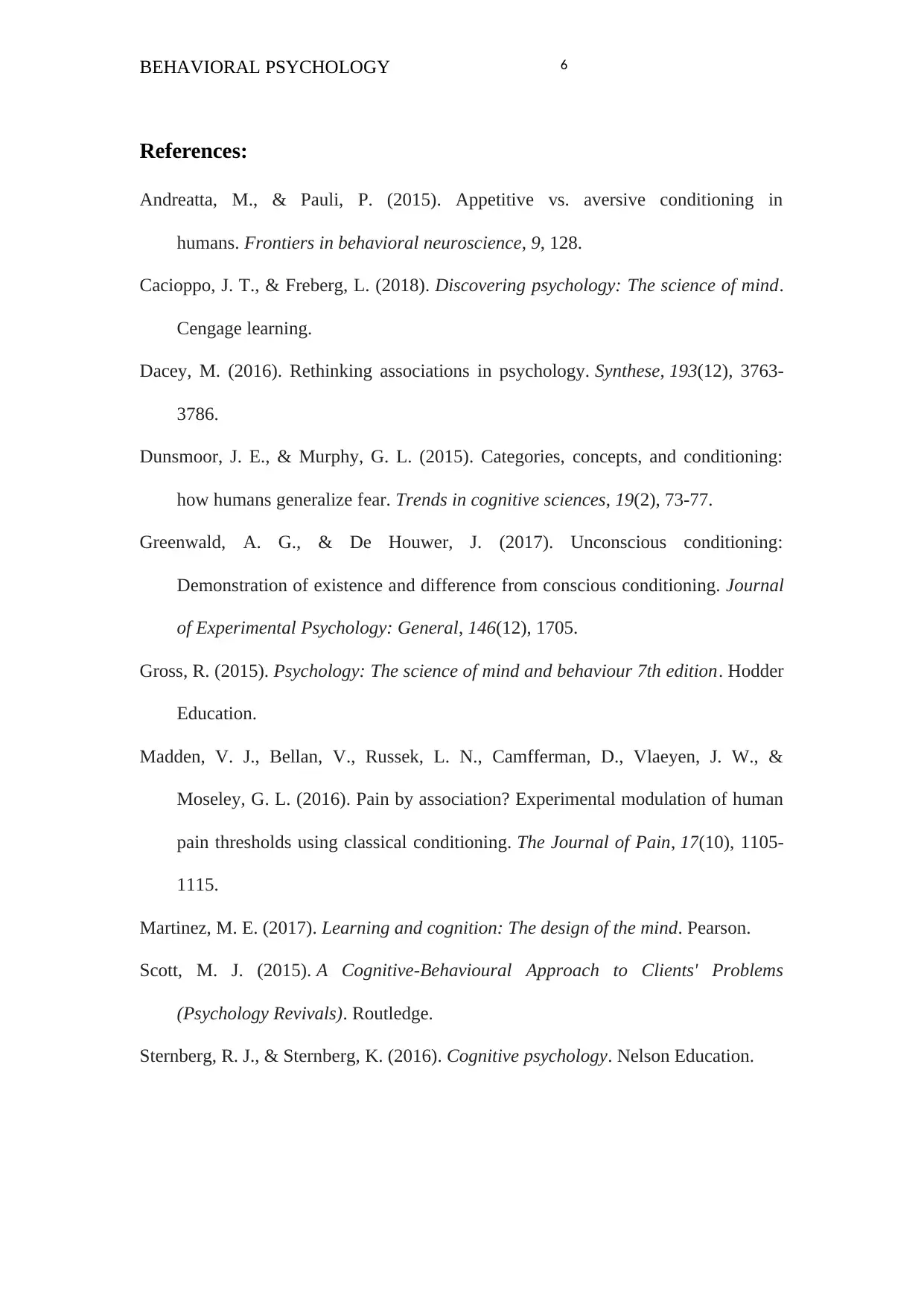
6BEHAVIORAL PSYCHOLOGY
References:
Andreatta, M., & Pauli, P. (2015). Appetitive vs. aversive conditioning in
humans. Frontiers in behavioral neuroscience, 9, 128.
Cacioppo, J. T., & Freberg, L. (2018). Discovering psychology: The science of mind.
Cengage learning.
Dacey, M. (2016). Rethinking associations in psychology. Synthese, 193(12), 3763-
3786.
Dunsmoor, J. E., & Murphy, G. L. (2015). Categories, concepts, and conditioning:
how humans generalize fear. Trends in cognitive sciences, 19(2), 73-77.
Greenwald, A. G., & De Houwer, J. (2017). Unconscious conditioning:
Demonstration of existence and difference from conscious conditioning. Journal
of Experimental Psychology: General, 146(12), 1705.
Gross, R. (2015). Psychology: The science of mind and behaviour 7th edition. Hodder
Education.
Madden, V. J., Bellan, V., Russek, L. N., Camfferman, D., Vlaeyen, J. W., &
Moseley, G. L. (2016). Pain by association? Experimental modulation of human
pain thresholds using classical conditioning. The Journal of Pain, 17(10), 1105-
1115.
Martinez, M. E. (2017). Learning and cognition: The design of the mind. Pearson.
Scott, M. J. (2015). A Cognitive-Behavioural Approach to Clients' Problems
(Psychology Revivals). Routledge.
Sternberg, R. J., & Sternberg, K. (2016). Cognitive psychology. Nelson Education.
References:
Andreatta, M., & Pauli, P. (2015). Appetitive vs. aversive conditioning in
humans. Frontiers in behavioral neuroscience, 9, 128.
Cacioppo, J. T., & Freberg, L. (2018). Discovering psychology: The science of mind.
Cengage learning.
Dacey, M. (2016). Rethinking associations in psychology. Synthese, 193(12), 3763-
3786.
Dunsmoor, J. E., & Murphy, G. L. (2015). Categories, concepts, and conditioning:
how humans generalize fear. Trends in cognitive sciences, 19(2), 73-77.
Greenwald, A. G., & De Houwer, J. (2017). Unconscious conditioning:
Demonstration of existence and difference from conscious conditioning. Journal
of Experimental Psychology: General, 146(12), 1705.
Gross, R. (2015). Psychology: The science of mind and behaviour 7th edition. Hodder
Education.
Madden, V. J., Bellan, V., Russek, L. N., Camfferman, D., Vlaeyen, J. W., &
Moseley, G. L. (2016). Pain by association? Experimental modulation of human
pain thresholds using classical conditioning. The Journal of Pain, 17(10), 1105-
1115.
Martinez, M. E. (2017). Learning and cognition: The design of the mind. Pearson.
Scott, M. J. (2015). A Cognitive-Behavioural Approach to Clients' Problems
(Psychology Revivals). Routledge.
Sternberg, R. J., & Sternberg, K. (2016). Cognitive psychology. Nelson Education.
1 out of 7
Related Documents
Your All-in-One AI-Powered Toolkit for Academic Success.
+13062052269
info@desklib.com
Available 24*7 on WhatsApp / Email
![[object Object]](/_next/static/media/star-bottom.7253800d.svg)
Unlock your academic potential
Copyright © 2020–2025 A2Z Services. All Rights Reserved. Developed and managed by ZUCOL.





